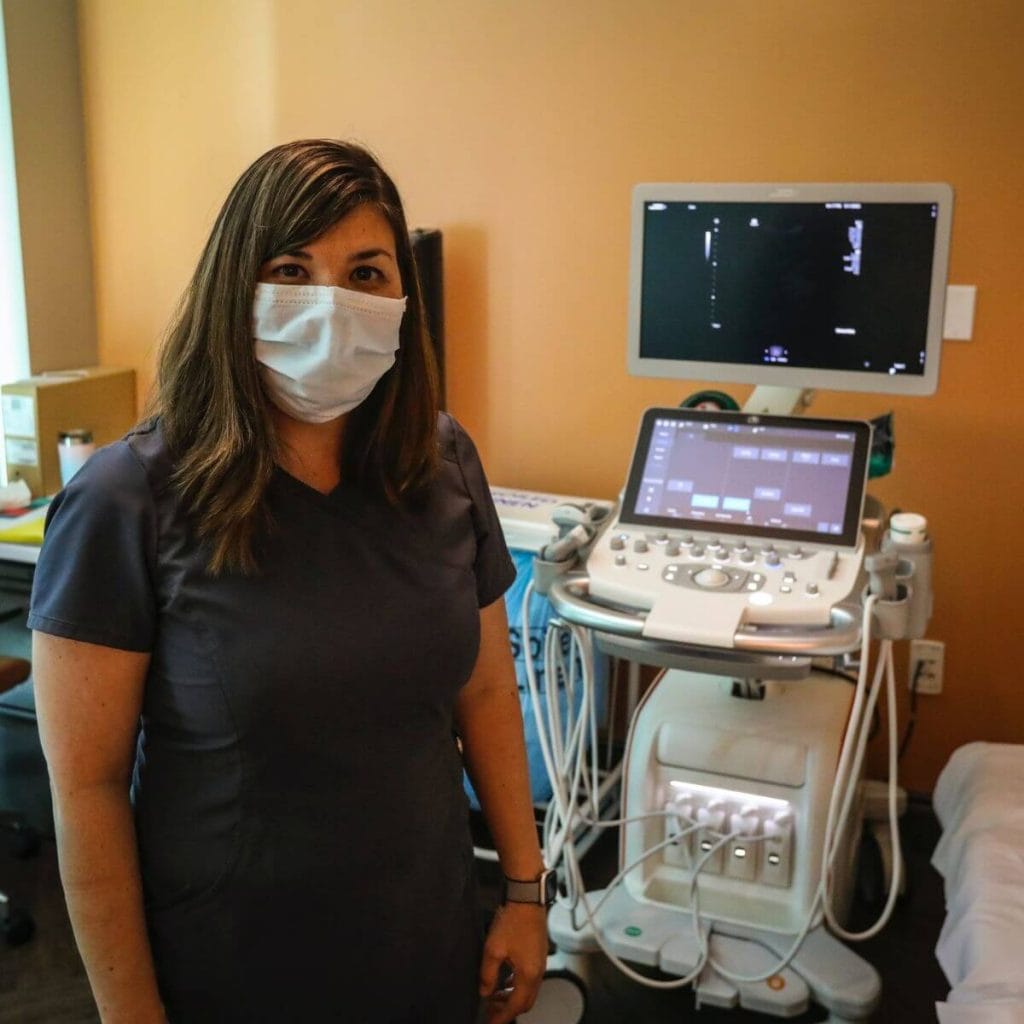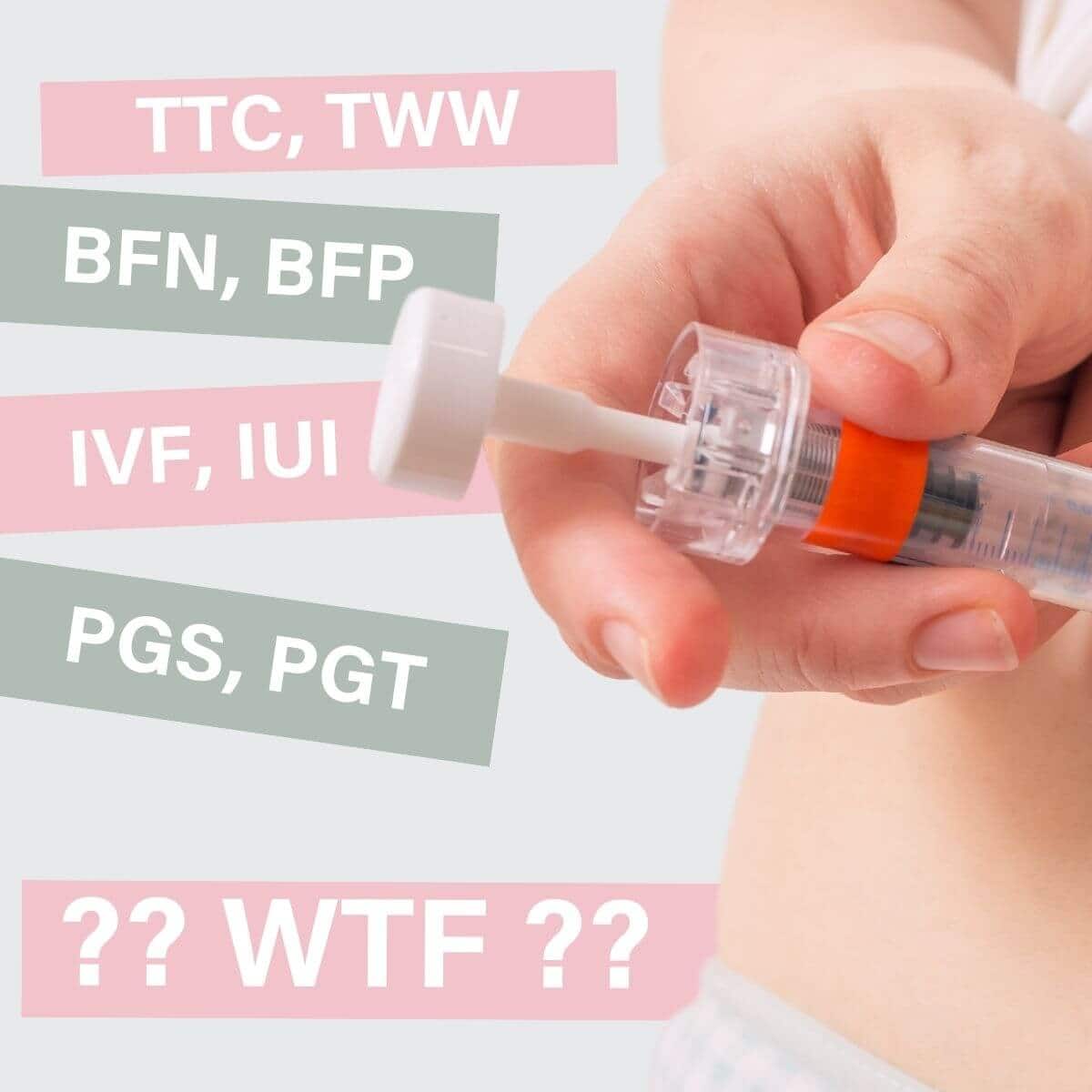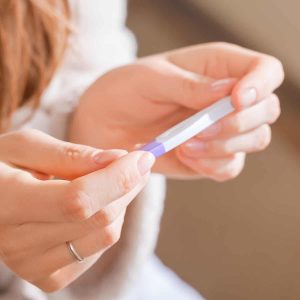Jump onto any infertility message board, Facebook page, or website, and you’re bound to find a plethora of helpful information. However, before you can fully appreciate that info, you’ll have to figure out how to decipher all the fertility acronyms so you can actually read it.
Anyone who navigates “Conception Highway” for a certain period has likely found a new way to speak about the process.
From nicknames to abbreviations, we rarely use real names and ideas to describe our experiences. For example, you’re unlikely to find someone waxing poetic about using intracytoplasmic sperm injection during their next IVF cycle.
The infertility community, which makes up approximately 10% of the American population, has created a universal shorthand used online, in doctors’ offices, and in fertility support groups.
If you’re new to the “trying unsuccessfully to get pregnant” crew, we’re here to help.
Learning to “talk the talk” with infertility abbreviations can be challenging. That’s why we’re breaking down some of the most common acronyms you will find when you start your journey.

This site contains affiliate links, meaning that we earn a small commission for purchases made through our site. We only recommend products we personally use, love, or have thoroughly vetted.
- TTC Acronyms: The Things You Say Before Treatment Starts
- 1. AF (Aunt Flo)
- 2. Baby Dance (Sex)
- 3. BBT (Basal Body Temperature)
- 4. BCP (Birth Control Pills)
- 5. B/W (Bloodwork)
- 5. CM (Cervical Mucus)
- 6. EPT (Early Pregnancy Test)
- 7. DPO (Days Past Ovulation)
- 8. ENDO (Endometriosis)
- 9. LMP (Last Menstrual Period)
- 10. MC or m/c (Miscarriage)
- 11. MF (Male Factor Fertility)
- 12. OV (Ovulation)
- 13. OPK or OPT (Ovulation Predictor Kits/Tests)
- 14. PCOS (Polycystic Ovary Syndrome)
- 15. RM or RPL (Recurrent Miscarriage or Recurrent Pregnancy Loss)
- 16. US (Ultrasound)
- Infertility Acronyms Related to Treatment Protocols
- 1. AH (Assisted Hatching)
- 2. ART (Assisted Reproductive Technologies)
- 3. ER (Egg Retrieval)
- 4. ET ( Embryo Transfer)
- 5. Frostie or Snow Baby (Frozen Embryo)
- 6. FSH (Follicle Stimulating Hormone)
- 7. HCG (human chorionic gonadotropin)
- 8. HSG (Hysterosalpingogram)
- 9. ICSI (Intra-Cytoplasmic Sperm Injection)
- 10. IUI (Intrauterine Insemination)
- 11. IVF (In Vitro Fertilization)
- 12. OHSS (Ovarian Hyperstimulation Syndrome)
- 13. p4/Prog (Progesterone)
- 14. PGD (Preimplantation Genetic Diagnosis)
- Post-Procedure Abbreviations
- Don’t Let These Infertility Acronyms Overwhelm You!
TTC Acronyms: The Things You Say Before Treatment Starts
I wish I could direct you to an Amazon listing for a dictionary of infertility acronyms and nicknames. Unfortunately, such a book doesn’t exist.
Instead, we’re here to guide you through the complicated world of fertility-related abbreviations, starting with a trying to conceive (TTC) abbreviation list, a.k.a. all the terms you need to know when you’re trying to conceive naturally.
1. AF (Aunt Flo)
While you could easily refer to your period as, well, a period, you’ll often see fellow pregnancy hopefuls talking about AF or Aunt Flo. This is just a silly way to describe your monthly friend who comes to visit.
So, if you see AF in an article, just know they’re talking about a woman’s period.
2. Baby Dance (Sex)
There’s no denying the mental health effects that can come with trying to get pregnant or seeking infertility treatments. To combat these struggles, we have to look for ways to keep things light and silly from time to time.
Baby dance is another way of describing sex during the fertility process. But why just call it sex when you can get a little goofy with it?
3. BBT (Basal Body Temperature)
Basal body temperature or BBT is a valuable tool for those hoping for a positive pregnancy test. By taking your resting body temperature first thing in the morning, you can track when ovulation is likely to occur.
4. BCP (Birth Control Pills)
Okay, I know it seems counterproductive to use birth control pills as a helpful tip to conceive. Strangely enough, however, taking a BCP can help get your body back on track when you’re dealing with irregular periods.
Many doctors, mine included, will temporarily put you on these to start your fertility treatment protocol.
5. B/W (Bloodwork)
Ahhh, B/W or bloodwork – an integral component in any infertility process. Whether undergoing an initial fertility workup, IVF procedure, or blood pregnancy test, you can rest assured you’ll be getting blood drawn more than once.
5. CM (Cervical Mucus)
While not the most appetizing topic to address, cervical mucus (CM) is a big help when you’re TTC. When you start noticing egg white cervical mucus, it helps determine when ovulation will occur.
6. EPT (Early Pregnancy Test)
An EPT, early pregnancy test, is a type of urinary home pregnancy test popular among the TTC community.
7. DPO (Days Past Ovulation)
Since the egg is released for possible fertilization during ovulation, this is the most integral time in the conception process.
Hopeful parents use the number of days past ovulation (DPO) to calculate how long it’s been since pregnancy possibly occurred and how soon they can take a test.

8. ENDO (Endometriosis)
As Endometriosis (ENDO) is a common cause of infertility, references to this infertility acronym are commonplace in conception-related content.
9. LMP (Last Menstrual Period)
Prepare yourself to be asked about your LMP, or last menstrual period, time and time again when you’re hoping to get pregnant. Doctors use this as a timeline marker for your menstrual cycle.
10. MC or m/c (Miscarriage)
In the unfortunate event that you’re looking for content about pregnancy loss and miscarriage, you might find it referenced as MC or m/c.
11. MF (Male Factor Fertility)
Many doctors and patients notate male factor fertility issues with an MF. Some of these included poor sperm quality or motility and low sperm counts.
While many people think of fertility problems as primarily a female issue, it might surprise you that male factors are present in up to 50% of infertility cases. Doctors will perform a semen analysis (SA) to identify these.
12. OV (Ovulation)
When you’re trying to get pregnant, ovulation (OV) will be a significant component in the process. After all, if you’re not ovulating, conception is impossible.
13. OPK or OPT (Ovulation Predictor Kits/Tests)
Unless you’re completely in sync with your body and all its strange idiosyncrasies, there’s a good chance you’ll have no idea when ovulation is taking place. That’s where an ovulation predictor kit or test comes in, a.k.a. an OPK OR OPT.
There are tons of different options, such as ovulation tracker apps or ovulation test strips, to help you pinpoint the precise day and time you’ll ovulate.
14. PCOS (Polycystic Ovary Syndrome)
Polycystic ovary syndrome (PCOS) and infertility often go hand-in-hand. This syndrome, which involves an imbalance in reproductive hormones, is one of the most common causes of infertility and affects up to 1-in-10 women.
15. RM or RPL (Recurrent Miscarriage or Recurrent Pregnancy Loss)
RM or RPL often identifies recurrent miscarriage or pregnancy loss on various infertility forums.
16. US (Ultrasound)
Whether you’re trying to conceive, checking for pregnancy, or identifying potential problems, your doctor will likely use ultrasounds (US) to help diagnose the situation. Transvaginal ultrasounds, the most commonly used US for fertility problems, can identify problems in areas such as the uterus, fallopian tubes, or cervix.
Infertility Acronyms Related to Treatment Protocols
Once you start the fertility treatment process, infertility acronyms can get even more challenging to understand. Put any worries aside, though; we’re here to help!
1. AH (Assisted Hatching)
Frequently used as a part of IVF protocols, assisted hatching (AH) involves placing a small crack in the exterior of an embryo to help it implant into the uterus.
2. ART (Assisted Reproductive Technologies)
Whether you’re talking about IVF or IUI procedures (more on these later!), these treatments fall under the umbrella of assisted reproductive technologies (ART). When you’re facing an inability to get pregnant naturally, these are often the next step.
3. ER (Egg Retrieval)
Doctors will perform an outpatient surgery during an IVF cycle, known as an egg retrieval (ER), to collect developing eggs from the patient’s ovarian follicles.
4. ET ( Embryo Transfer)
The final piece in any IVF procedure is embryo transfer (ET). This involves placing a developing embryo directly into the uterus through US technology.
If your physician uses a frozen embryo during this process, it’s called a frozen embryo transfer or FET.
5. Frostie or Snow Baby (Frozen Embryo)
If you’re ever scrolling through a message board and come across the term “frostie” or “snow baby,” the writer probably isn’t talking about ice cream treats. They’re actually discussing any baby who develops from a frozen embryo.
6. FSH (Follicle Stimulating Hormone)
Follicle-stimulating hormones (FSH) are responsible for the growth of eggs in the ovaries. You’ll probably have to take FSH injections during an IVF cycle to encourage your body to produce more eggs than usual.
7. HCG (human chorionic gonadotropin)
When you become pregnant, your body will start producing a hormone called human chorionic gonadotropin (hCG). hCG helps doctors prove whether conception has occurred and if the pregnancy continues to develop.
8. HSG (Hysterosalpingogram)
An HSG (hysterosalpingogram) is a typical test you might experience during ART procedures. It allows doctors to observe your uterus and fallopian tubes.
9. ICSI (Intra-Cytoplasmic Sperm Injection)
For sperm with poor motility, physicians might utilize a technique called intra-cytoplasmic sperm injection (ICSI) during an IVF procedure. A single sperm is injected directly into an egg during this step.
10. IUI (Intrauterine Insemination)
An IUI, or intrauterine insemination, is often the first type of reproductive technology doctors will use to solve fertility troubles.
This process involves collecting a sperm sample and placing it directly into the uterus during an outpatient procedure.
11. IVF (In Vitro Fertilization)
In vitro fertilization (IVF) is one of the most common ART protocols. During this process, your reproductive endocrinologist (RE) will fertilize your eggs outside of your body and then place the developing embryo back in.
This protocol is also beneficial if an individual or couple requires donor eggs to conceive.
12. OHSS (Ovarian Hyperstimulation Syndrome)
During the follicle stimulation phase, the medications used can adversely affect your body. One significant risk factor is OHSS, also known as ovarian hyperstimulation syndrome. Your practitioner will likely perform rigorous testing to ensure this isn’t occurring.
13. p4/Prog (Progesterone)
Progesterone is one of the hormones required to support an embryo and baby throughout pregnancy.
14. PGD (Preimplantation Genetic Diagnosis)
If you or your partner struggle with some type of genetic disorder and want to avoid passing it on to your children, your reproductive endocrinologist can help. They can conduct a genetic screening on your embryos before transferring them into your uterus.

Post-Procedure Abbreviations
When your cycle day has come and gone, and you’re anxiously awaiting your pregnancy test results, these are some of the infertility abbreviations you might come across.
1. 2WW or TWW (Two Week Wait)
The two-week wait (TWW or 2WW) is the period after an embryo transfer or ovulation when you’re waiting to find out whether your cycle was a success.
2. Baby Dust (Wishes for Good Luck)
Wishing someone baby dust is the equivalent of saying “Fingers Crossed!” or “Break a Leg!” when they’re going through fertility struggles.
3. Beta (hCG Blood Pregnancy Test)
We’ve already established that hCG is the hormone present in blood work when you’re pregnant. Did you know, though, that the test itself has a nickname?
If you hear someone refer to a beta test after ART treatment, they’re talking about blood pregnancy tests.
4. BFN or BFP (Big Fat Negative or Positive)
When you get a positive or negative pregnancy test, the infertility community refers to it as a BFN or a BFP – big fat negative or big fat positive!
5. EDD (Estimated Due Date)
So, you’ve put in the work to have a baby and have finally received the positive pregnancy test you’ve dreamt about! Your doctor will give you an estimated due date (EDD) as to when your baby will arrive.
6. HPT (Home Pregnancy Test)
Once there’s a high enough level of those gorgeous hCG hormones floating around in your system, you can take a home pregnancy test (HPT) to try and get your BFP.
7. POAS (Pee on a Stick)
What do you have to do with those home pregnancy tests we just mentioned? That’s right – pee on them.
With your first morning urine, also called the FMU, you’re going to pee on a stick to determine whether your efforts worked. You’ll frequently see fellow fertility warriors talk call this POAS.
8. PG (Pregnant)
PG – pregnant, the answer you’ve hoped for, and the first day of the rest of your life.
9. PUPO (Pregnant Until Proven Otherwise)
After an infertility cycle date has come and gone, you might be tempted to view yourself as still not being pregnant.
Why stress yourself out with negativity, though?
PUPO is a mantra every hopeful parent deserves. With all those high levels of progesterone and estrogen rolling around your system, why not just assume you’re “pregnant until proven otherwise?”
Don’t Let These Infertility Acronyms Overwhelm You!
Whether you’re hoping to have your first baby or struggling with secondary infertility, the process can be exhausting. Add in a wide range of weird infertility abbreviations, and things get chaotic.
Keep in mind, though; these acronyms are a part of a beautiful community that’s ready and willing to help build you up and carry you through this complicated moment in your life.
Do you recognize any of these infertility acronyms?










